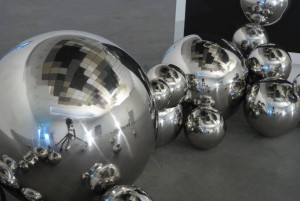10th Kaunas Biennial 2015
Threads: A Phantasmagoria about Distance
18th September – 31st December 2015
M. K. Čiurlionis National Museum of Art
Kaunas, Lithuania
Curator of the principal exhibition: Nicolas Bourriaud
Artistic Director: Virginija Vitkienė
Nicolas Bourriaud:
Threads: A Fantasmagoria about Distance ambitions both to approach the form of phantasmagoria and address the way today’s artists include the notion of distance in their works: in a globalized and digitalized world, how does art deal with transportation, real time communication? What is the current shape of the presence /absence dialectics? How do artists present absent realities? “Move bits, not atoms”, said the web activist Nicholas Negroponte in the 1990’s.
As a metaphor, Threads also stresses the parallels between today’s art and the spectacle of phantasmagoria, focusing on the similarities with this proto-movie theatre both in terms of techniques and intellectual issues, and lead the way to another possible history of art, where feature films and installations would share a common ancestor.
By doing so, it alludes to the spectral as an emerging mode of visualisation anchored in internet culture: furtive apparitions, gaseous, infra-thin or filigree-like images, pseudo-telepathy, ventriloquy or magnetic phenomenons are part of a new culture of the visible aiming to reconcile science and poetry, technology and image analysis, but in a production context dominated by digital tools.
Based on this link between science, poetry and spiritualism, Threads is an exhibition about art as a system that connects itself to a different time and/or space. The artwork as a telegraphic device, entering in contact with something happening somewhere else, in another realm, world, place or times…
Nicolas Bourriaud on curatorship and positioning art
In his first visit to Lithuania Nicolas Bourriaud presented his ideas for the exhibition at Kaunas Biennial and also had to answer some questions. Some key questions were: What makes a good exhibition? And what is the role of the curator in developing a visualisation of his own ideas?
“I will compare an exhibition to an opera, where the curator writes the libretto and the music is provided by the artists”, – he said. According to N. Bourriaud, the curator should not dominate in any exhibition. A certain balance must be maintained. “Only artists contextualise and visualise ideas. It is them and not the curator, who make art,” – said N. Bourriaud. Therefore, a visitor to a well-curated exhibition has the opportunity to perceive the works from two positions: as a story linked by an underlying problem or to try and understand the perspective of each individual artist.
“I would compare curating exhibitions to camping – an opportunity to broaden the boundaries of your knowledge and as thus to grow your roots by travelling (on a basis of radicant rooting process, when the roots grow outwards on the surface of the soil rather then growing deeper)” – the curator and the director of the School of Fine Art in Paris N. Bourriaud explained the reasons of his visit to a small town of a small country. The curator admitted that he was enticed not only by the country’s geographical but also by the Kaunas Biennial context itself, which is closely linked with the textile culture. In his presentation the curator emphasised the evident change in communication and our thirst for knowledge that have been influenced by the internet and are crucial for the present and future of our culture.
“Unique processes, which have never been experienced throughout the human history, are happening all around us. The last known place on Earth was discovered in 2001. Technologies enable us to know everything there is to know about the time in which we now live. Therefore, the only area, which has not yet been explored, is our past. That is one of the reasons why artistic thought still pursues this unknown phenomenon. Nowadays, when the amount of information received by us everyday is enormous, the goal of the curator is to offer a new way of thinking, a different point-of-view,” – N. Bourriaud spoke about the challenges of curating. The theorist believes that globalisation has pushed localisation to the front of our attention – small communities and small worlds, even the concept of culture created by individual artists’ today is more important than the megacities or large structures. That is why the city as a place – Kaunas, Taipei and Paris, in N. Bourriaud’s cultural understanding is much more important than the countries (Lithuania, Taiwan or France).
Image: ‘The Skull’ by Saâdane Afif, who is one of the artists of exhibition “Threads: Fantasmagoria about Distance”, curated by Nicolas Bourriaud. Photo courtesy: cadifroehlich.com. Courtesy Kaunas Biennial.


